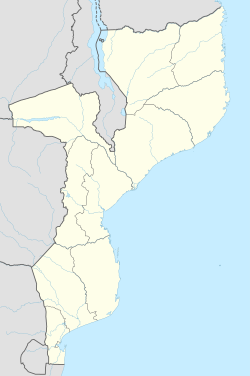You can help expand this article with text translated from the corresponding article in Portuguese. (December 2015) Click [show] for important translation instructions.
|
This article needs additional citations for verification. (October 2019) |
The Fort of São Sebastião lies at the northern end of Stone Town on the Island of Mozambique. It is the oldest complete fort still standing in sub-Saharan Africa. Construction by the Portuguese began in 1558, and it took about fifty years to complete.
| Fort São Sebastião | |
|---|---|
| Stone Town, Nampula Province in Mozambique | |
 | |
| Coordinates | 15°01′44″S 40°44′35″E / 15.029°S 40.743°E |
| Site history | |
| Built | 1558 |
| Built by | Portuguese Empire |
Immediately beyond the fort is the recently restored Chapel of Nossa Senhora de Baluarte, built in 1522, which is considered to be the oldest European building in the southern hemisphere. It is also one of the best examples of Manueline vaulted architecture in Mozambique.[1]
3D documentation
editIn 2013, the Zamani Project documented Fort of São Sebastião with terrestrial 3D laser scanning.[2][3][4] The non-profit research group from the University of Cape Town (South Africa) specialises in 3D digital documentation of tangible cultural heritage. The data generated by the Zamani Project creates a permanent record that can be used for research, education, restoration, and conservation.[5][6][7]
External links
editNotes
edit- ^ Mary Fitzpatrick (2010). Mozambique. Lonely Planet. pp. 211–. ISBN 978-1-74104-888-9.
- ^ "Site - fort Sao Sebastiao - Mozambique Island". zamaniproject.org. Retrieved 8 October 2019.
- ^ Rüther, Heinz; Rajan, Rahim S. (2007). "Documenting African Sites: The Aluka Project". Journal of the Society of Architectural Historians. 66 (4): 437–443. doi:10.1525/jsah.2007.66.4.437. ISSN 0037-9808. JSTOR 10.1525/jsah.2007.66.4.437.
- ^ Rüther, Heinz (2002). "An African Heritage Database: The Virtual Preservation of Africa's Past" (PDF). International Society for Photogrammetry and Remote Sensing. Retrieved 2 October 2019.
- ^ Rüther, Heinz. "An African heritage database, the virtual preservation of Africa's past" (PDF). www.isprs.org.
- ^ Rajan, Rahim S.; Rüther, Heinz (30 May 2007). "Building a Digital Library of Scholarly Resources from the Developing World: An Introduction to Aluka". African Arts. 40 (2): 1–7. doi:10.1162/afar.2007.40.2.1. ISSN 0001-9933.
- ^ Rüther, Heinz; Rajan, Rahim S. (December 2007). "Documenting African Sites: The Aluka Project". Journal of the Society of Architectural Historians. 66 (4). University of California Press: 437–443. doi:10.1525/jsah.2007.66.4.437. JSTOR 10.1525/jsah.2007.66.4.437. Archived from the original on 24 September 2019. Retrieved 8 October 2019.
